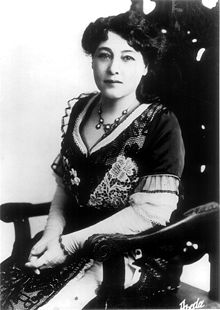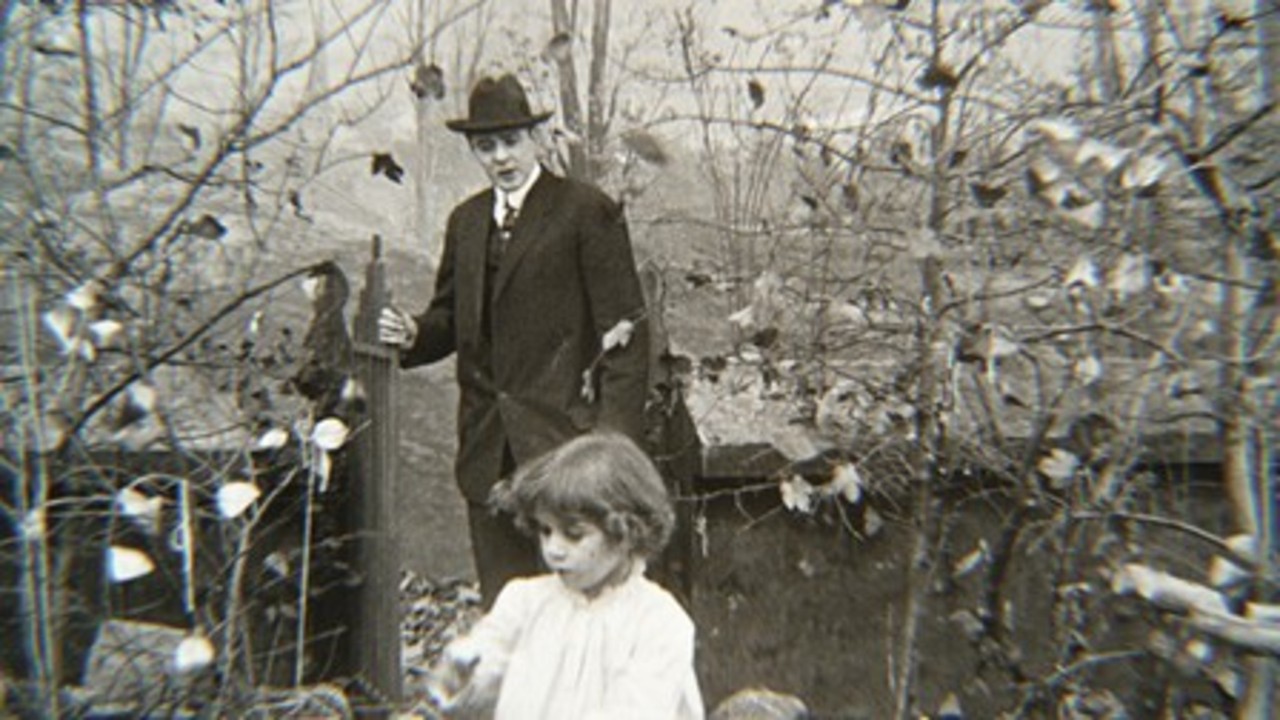The Greatest Pioneering Filmmaker You’ve Never Heard Of
#45: Short Films Directed by Alice Guy-Blaché
Cabbage Fairy – 1896
At the Hypnotist/The Burglers – 1898
The Landlady/Turn of the Century Surgery – 1900
Midwife to the Upper Class – 1902|
Faust and Mephistopheles – 1903
The Consequences of Feminism/The Cruel Mother/The Drunken Mattress/Madame’s Cravings/The Parish Priest’s Christmas/The Truth Behind the Ape-man – 1906
A Four-Year-Old Hero/The Fur Hat/The Irresistible Piano/On the Barricade/The Race for the Sausage/The Rolling Bed – 1907
Making an American Citizen – 1912
 I had my mind blown this week. I thought I had a good grasp on the major names in early cinema – innovators like the Lumière Brothers and George Méliès. But I had never heard of Alice Guy-Blaché. She was no small figure in the early days of film, despite her obscurity now. Alice Guy-Blaché was the director and writer of hundreds of films, the head of production for a major French film studio (Gaumont), a pioneer in colorization and special effects, and the only woman ever to build and run her own film studio (Solax). Guy-Blaché even vies for the title of “first” in fictional filmmaking, with an imaginative short film called Cabbage Fairy that she made in 1896.
I had my mind blown this week. I thought I had a good grasp on the major names in early cinema – innovators like the Lumière Brothers and George Méliès. But I had never heard of Alice Guy-Blaché. She was no small figure in the early days of film, despite her obscurity now. Alice Guy-Blaché was the director and writer of hundreds of films, the head of production for a major French film studio (Gaumont), a pioneer in colorization and special effects, and the only woman ever to build and run her own film studio (Solax). Guy-Blaché even vies for the title of “first” in fictional filmmaking, with an imaginative short film called Cabbage Fairy that she made in 1896.
Through Fandor’s streaming service I was able to watch 18 of Alice Guy-Blaché’s short films, ranging from one minute to 16 minutes (I also found Cabbage Fairy on YouTube). Very early silent films often look crude to us now, with their painted sets, barely existent plots and “primitive” effects. But to see them only in that light – to complain, for instance, that the backdrops in The Burglars look fake – is to entirely misunderstand what you are looking at. Watching Cabbage Fairy, in which a cheerful young woman plucks naked, wriggling babies from a bed of giant cabbages, may not help you understand how babies are made – but it lets you watch the birth of an art form. Alice Guy-Blaché was a 21 year old secretary to Leon Gaumont when she saw her first film, Workers Leaving the Lumière Factory. She was so taken with the possibilities of filmmaking that she borrowed a camera and received permission from her boss to make her own film, as long as it didn’t interfere with her secretarial work Cabbage Fairy, finished two years later, was only the first in a long line of films Guy-Blaché made. As for her boss? Gaumont turned to film himself and made Alice the head of his Paris production department.
 Guy-Blaché made movies in a variety of genres. The Cruel Mother and On the Barricade are both sentimental melodramas. The Cruel Mother, in which a woman beats and starves her young stepson, is naturalistic enough to be hard to watch even now. The Parish Priest’s Christmas is a heart tugger of the religious kind. It’s Christmas day, and a poor parish church is missing a baby Jesus for their creche. The merchant who sells such figures is too greedy to accept all the money the humble priest has to offer, and the faithful are compelled to kneel and pray in front of an empty creche. (Don’t worry: the Holy Mother has them covered.) Many of her films, both comedy and drama, have large crowd scenes and energetic action. She also increasingly shot in outdoor locations, quickly moving beyond the stiff, stage-bound feeling of many early silents.
Guy-Blaché made movies in a variety of genres. The Cruel Mother and On the Barricade are both sentimental melodramas. The Cruel Mother, in which a woman beats and starves her young stepson, is naturalistic enough to be hard to watch even now. The Parish Priest’s Christmas is a heart tugger of the religious kind. It’s Christmas day, and a poor parish church is missing a baby Jesus for their creche. The merchant who sells such figures is too greedy to accept all the money the humble priest has to offer, and the faithful are compelled to kneel and pray in front of an empty creche. (Don’t worry: the Holy Mother has them covered.) Many of her films, both comedy and drama, have large crowd scenes and energetic action. She also increasingly shot in outdoor locations, quickly moving beyond the stiff, stage-bound feeling of many early silents.
She was not simply a skilled director, but a titan in the early years of filmmaking. She moved in the same circles as the greats whose names we know, but somehow her name was largely lost to us. Why?
Guy-Blaché also had a remarkably sure hand with comedy. Some of the physical comedies are simply silly (a crowd trying to chase down a dog with a string of sausages in the aptly named The Race for the Sausage), but others are surprisingly clever. In The Drunken Mattress a staggering drunk is accidentally sewn inside a mattress. The rest of the film is comprised of a woman trying to deliver the mattress without realizing that there is a man inside of it. Mayhem ensues. My favorite comedy was A Four Year Old Hero, in which a tiny girl slips away from her nanny at the park, then fights crime and averts tragedies. It’s such a simple premise, but the little girl delivers her performance with winning nonchalance.
 Gender and family roles were of particular interest to Alice Guy-Blaché. At least three of her short films involved babies and cabbage patches (including Madame’s Cravings, a real hoot about a hugely pregnant woman who craves…well, pretty much everything she sees), but even more than these sly little comments on family planning, Guy extensively explored the interactions between men and women. In Consequences of Feminism gender roles have completely reversed. Men iron, clean, and tend to babies while women idle, leer, and drink. Eventually the men revolt and reclaim their “rightful” place in society, but by then Guy-Blaché has made that place look lazy and boorish. Making an American Citizen is an even stronger feminist tale. Made after Alice herself immigrated to the United States, Making an American Citizen tells the story of a Russian peasant couple trying to acclimate to their new culture. For the husband, Ivan, this means learning that it is no longer acceptable to beat his wife and treat her like a pack mule. While American men intervene on her behalf several times, it is finally the wife’s own testimony against her husband that sends him to prison for six months. He comes back chastened, repentent, or as the intertitle tell us “Completely Americanized!” This allows the couple to live happily ever after, although it may present a sunnier picture of gender relations in the U.S. than has ever been realistic.
Gender and family roles were of particular interest to Alice Guy-Blaché. At least three of her short films involved babies and cabbage patches (including Madame’s Cravings, a real hoot about a hugely pregnant woman who craves…well, pretty much everything she sees), but even more than these sly little comments on family planning, Guy extensively explored the interactions between men and women. In Consequences of Feminism gender roles have completely reversed. Men iron, clean, and tend to babies while women idle, leer, and drink. Eventually the men revolt and reclaim their “rightful” place in society, but by then Guy-Blaché has made that place look lazy and boorish. Making an American Citizen is an even stronger feminist tale. Made after Alice herself immigrated to the United States, Making an American Citizen tells the story of a Russian peasant couple trying to acclimate to their new culture. For the husband, Ivan, this means learning that it is no longer acceptable to beat his wife and treat her like a pack mule. While American men intervene on her behalf several times, it is finally the wife’s own testimony against her husband that sends him to prison for six months. He comes back chastened, repentent, or as the intertitle tell us “Completely Americanized!” This allows the couple to live happily ever after, although it may present a sunnier picture of gender relations in the U.S. than has ever been realistic.
I’ve been at this #52FilmsByWomen project for over a year now (never mind that it should have been completed in a year – life has a way of complicating things), and Alice Guy-Blaché has been one of my happiest surprises. She was not simply a skilled director, but a titan in the early years of filmmaking. She moved in the same circles as the greats whose names we know, but somehow her name was largely lost to us. Why? Part of the blame surely goes to Gaumont, who wrote a history of his studio and completely eliminataed Guy-Blaché from the story. She asked him to correct the account, but it never happened and she remained effectively erased from the official account of Gaumont Studio. That’s only a partial explanation for why a director so creative and prolific faded so quickly after her career ended. Gender almost certainly played a part: if history teaches us anything, it’s that women’s roles have too often been obscured. Gaumont’s story is an example of a wider phenomenon: the one’s who write history shape it – and history has largely come to us through men.
Alice Guy-Blaché deserves better, and thankfully is starting to receive the recognition she’s long merited. A documentary is in the works, and there are now several books about her career. Guy-Blaché’s own memoir remains in print, too – written in large part because she was trying to preserve her place in film history. Thanks to the variety of viewing platforms available it’s much easier now to find and view many of Alice Guy-Blachés films. I feel genuinely lucky to have stumbled across them myself.

